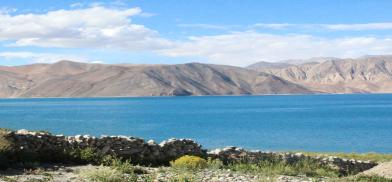Challenges in Ladakh: Appropriate technology can improve standard of living
Ladakh is endowed with an excellent water supply through pristine rivers which flow across the land. This water can be used in the greenhouses to grow vegetables, fodder and other produce.

Recently we spent seven lovely days in Ladakh visiting various places. We visited Leh, Nubra Valley, Turtuk, Thang (LOC), Pangong Lake and various places in between.
The trip was backbreaking with quite a lot of travel on gravel and potholed roads. I feel that the trip is meant for young and fit people rather than older people like us who are more than 70 years of age.
The road trip though was adequately compensated by the fantastic scenery - which is like a moonscape. I do not think there is any other place on this earth that has snow-clad mountains, sand dunes and a beautiful clear water river flowing in one scene. Yet in all the places that we travelled this was the scenery. Thus it is once in a lifetime opportunity to visit and stay in Ladakh.
The weather in mid-May was perfect. In fact, the weather gods were really kind to us since not a single day it rained or snowed while we crisscrossed Ladakh.
There is a very heavy presence of the army since this is a sensitive area (surrounded by Pakistan and China) but the army is very well assimilated with the local population. We never saw army personnel with cocked automatic guns as one sees them in Kashmir. Part of the reason is that a large number of Ladakhi youngsters join the army and also army provides good roads and supplies.
Need for better living standards
The whole Ladakh region is a difficult terrain and an inhospitable place to live. India is spending huge resources and funds to have the army stationed there to protect against Pakistan and Chinese intrusions.
It is therefore necessary to use local renewable energy resources of solar, wind and water for creating sustainable and a better standard of living for the local population who have otherwise few income opportunities..
In the coming years, tourism will further increase and with better roads and facilities it has the making of becoming another Kashmir. However, increased tourism will bring in new challenges. In order to overcome these and other challenges here are a few thoughts.
Infrastructure upgradation
The Leh airport reminded me of the Indian airports of the 70s and 80s. It is a small airport with hardly any facilities. The bathrooms were dirty with broken doors in the arrival area and the luggage belt was very small leading to crowding and chaos. I think for the sake of increased tourism the government should build a good new airport. We saw that a new civilian airport is coming up in the vicinity.
All-weather roads are the most important part of making Ladakh habitable. Mountain roads with heavy snowfall deteriorate rapidly. The melting snow water has to be drained properly through culverts. We saw many places culverts being erected and put in place. If this is done on all the major roads, then one can have good all-weather motorable roads.
The Border Road Organization (BRO), a government entity, is working to make that happen, but it has to be speeded up with funds and machines.
Also, the Himalayan rocks are very soft and prone to landslides with snow and rain. We saw rocks in steel meshes being used to arrest landslides. However, I feel that strong and short bushes should also be planted all along the roads to check the landslide since their root systems will bind the soil.
Solar and wind energy
I was amazed at the topography of the Ladakh desert. The solar energy potential is tremendous and with an average insolation of 4-5 kWhr/m2 – day and almost 300 days of sunshine it is a solar haven.
All the houses should therefore be heated by solar water heating systems. They will provide hot water for general usage plus will heat the houses. Today excellent insulating materials are available which can make the existing or new houses energy-wise very efficient. This together with solar heating can make the dwellings very comfortable.
Solar PV can be used for LED-based lighting and cooking via induction cookers. For Chinese-type cooking (which is prevalent in Ladakh) induction cooking is excellent. Naturally, storage of solar PV electricity in different batteries is a challenge.
All Solar PV systems should be decentralized and not made into megawatt sizes. Setting up the grid electricity in such a tough terrain has its own problems and challenges. Solar energy is decentralized, and it should be used as such. Besides decentralization also helps in matching easily with small battery banks.
Similarly, there is tremendous wind potential in Ladakh. But it is very site-specific. Hence small 1-10 kW wind turbines should be used for homes. Many times when the sun is not shining, the wind blows and that can be used at night.
High-tech industries powered by Solar PV and wind can be useful for generating income for local youth. They will also help keep the Ladakhi air clean and will help in creating jobs and products.
Water and Greenhouses
Ladakh is endowed with an excellent water supply through pristine rivers which flow across the land. This water can be used in the greenhouses to grow vegetables, fodder and other produce. Some work by the Defence Research and Development Organisation (DRDO) has been done but it needs to be scaled up and made more efficient. We did not see a single lift irrigation scheme on these rivers. Fodder production will also help develop the dairy industry.
Though most of the water in Ladakh is pristine since it is coming from glaciers, there may be a high E. Coli count in it. It can easily be treated by solar thermal energy. Not only will it provide clean drinking water but may also help in heating homes via hot solar-heated water.
Sustainable living
There is a need to use very sophisticated technologies for making a sustainable living at these attitudes. The regular run-of-the-mill approach will not do. Thus the use of appropriate-size drones for transporting people and goods will be a great boon in such terrains.
Already the existing small villages and hamlets need to be made livable through these technologies. The youth from these areas will then help in building a better Ladakh and India.
(The writer is Director, Nimbkar Agricultural Research Institute (NARI), Phaltan, India. Views are personal. He can be reached at anilrajvanshi@gmail.com/www.nariphaltan.org)










Post a Comment